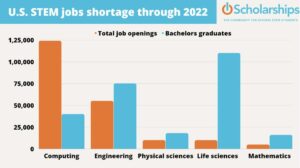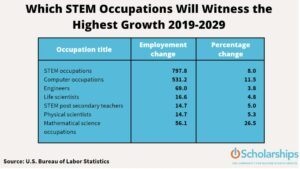STEM Job Shortage and What it Means for You
STEM is an acronym that stands for science, technology, engineering, and math. While traditionally, STEM employees have enjoyed more favorable labor market outcomes than their non-STEM counterparts, there has been a massive underrepresentation in STEM on the basis of gender, race, sexuality, and other socio-economic factors.
Increasingly, employers are realizing the importance of hiring minority communities in STEM, such as Latinx, Black/African, and other people of color. While that is welcome in terms of social justice and representation, hiring people regardless of their identity also makes better business sense. Given the current shortage of STEM jobs, minorities can do wonders to fuel the STEM pipeline. Now is a great time to consider entering the STEM field.
It is no secret that employees are leaving their jobs at record rates. Termed the “Great Resignation,” the past year has witnessed a massive number of employees quitting their jobs. According to the US Bureau of Labor Statistics, quit levels peaked in March 2022 as nearly 4.5 million employees left their jobs. Increasingly, employees are prioritizing flexibility, community, and inclusive culture, or “relational factors,” apart from higher compensation. As employees continue to quit the job market, there is an acute shortage of quality talent in the general labor market.

The supply of STEM Talent
The supply of STEM workers is heavily skewed in terms of its demographic, depending on factors such as race and gender. White workers are overrepresented in STEM jobs and comprise 67% of the STEM workforce, while accounting for 63% of the workforce across all occupations. White workers have an even higher representation in certain STEM fields like engineering.
On the other hand, minority communities are visibly underrepresented in STEM. In particular, the share of black and Hispanic workers in STEM fields is only a fraction of their overall share in the US workforce. Native Americans, Native Hawaiians, Pacific Islanders, and people who identify with two or more racial groups account for just 3% of STEM workers.
Why is the supply skewed?
STEM is a specialized field that demands a higher level of formal and technical education. Average standards of formal education are not equal across all groups and communities in the US. That is partly why some communities continue to be underrepresented in STEM fields.

STEM education is both expensive and time-consuming, factors that can prove to be hurdles for some students. The high costs and time required for a university-level education in STEM fields can be discouraging to students from certain backgrounds.
In addition, getting a STEM education can be difficult for students based on geographical and socio-economic factors. High school-level courses such as Calculus, Physics, Chemistry, and Algebra, which are critical for success in STEM fields, are inaccessible to many.
The Demand for STEM Workers
While talent shortage is a concern for most industries globally, the scenario is particularly grim for STEM fields. The US alone will have to fill nearly 3.5 million STEM jobs by 2025, in areas such as computing, engineering, and advanced manufacturing. Whether it be in Science, Technology, Engineering, or Mathematics, the high demand for STEM skills is fairly universal. Industries such as healthcare and technology will continue to witness long-term increases in the demand for skilled workers, regardless of short-term fluctuations.
According to the US Bureau of Labor Statistics, STEM occupations are forecast to grow two times faster than the total for all occupations over the next decade.
STEM Occupations With The Highest Growth Prospects
STEM is a vast field consisting of hundreds of different occupations. Some of these occupations will grow faster than others, depending on a variety of external economic factors. The mathematical science occupational group, which includes data scientists, mathematicians, and statisticians, is set to grow the fastest.
Computer occupations are expected to account for around two-thirds of all the STEM jobs created by 2019. Computer occupations are expected to grow approximately three times as fast, which means more than half a million new computer jobs by 2029. Within computer occupations, jobs for information security analysts, software developers, and computer and information research scientists are expected to grow at the fastest rate.
Benefits Of Working In STEM
Perhaps the most significant advantage of working in STEM fields is the higher wages they offer. High demand for STEM professionals, combined with an inadequate supply, translates to higher compensation. There is of course considerable variation in compensation according to the wide variety of professions covered by the STEM umbrella.
According to a study by the World Economic Forum, the top 25 college degrees by pay and demand are all in STEM subjects. On average, STEM employees make $93,000 per year, which is substantially higher than the national average.
In addition, the unemployment rate has historically been lower for STEM graduates. The unemployment rate is a critical indicator of both the overall health of the economy, as well as the security of individual professions. Even at the peak of the pandemic, the STEM unemployment rate was much lower than the non-STEM unemployment rate. This is further proof that STEM professions are less adversely impacted by external economic fluctuations.
Higher wages and lower unemployment only go to demonstrate that STEM graduates stand to benefit from a higher return on investment from their education.
Tips To Succeed In STEM
There are obvious entry barriers to the STEM field for students from certain underprivileged backgrounds. However, that should not be overly discouraging as there are several things you can do to maximize your chances of succeeding in a STEM career. Some of them are:
- Take advanced math and science classes in high school: Aim for the highest level of math and science in high school. Include classes in calculus, trigonometry, computing science, etc.
- Leverage community colleges: Developing competence in math and science in junior college is important if you’re looking to pursue a four-year degree. You can use community college as a stepping stone for further studies.
- Go beyond the classroom: Not all learning happens in class. Familiarize yourself with STEM subjects on your own. Read up on extra material on subjects you find interesting. Even things like visiting a museum or planetarium can be beneficial.
- Observe a STEM professional: There is a lot to be learned by observation. Ask your science teacher or school guidance counselor if they can arrange for you to watch an engineer or a doctor at work for a day.
- Be academically prepared: Ensure you have covered the basics before enrolling in college. Writing skills, basic math, and science are as important in STEM as critical thinking and problem-solving abilities.
While success in a STEM field will mostly depend on your drive and initiative, additional help is available.
For instance, the IOScholarship (IOS) offers thousands of customized STEM scholarship programs for students from underprivileged and underrepresented groups. This model of debt-free education has helped thousands of students have successful careers in STEM fields.
Tech company Lenovo has helped expose student volunteers to STEM through its own model initiative. It helps students from third grade to twelfth grade cross the digital divide by refurbishing used computers and placing them in the homes of students in low-income areas.
Similarly, Google’s Women Techmakers Program offers three months of free coding classes to women and minority students interested in technology.
Not all such initiatives come from Fortune 500 companies. Individuals and groups across the US offer mentoring services, partnerships, online classes, and webinars to improve access to STEM fields.
What does this mean for you?
There is no denying the huge gap between the demand and supply of skilled STEM professionals and adequate representation of these communities in STEM fields is long overdue. Given the current state of the economy, this is the perfect time for you to get a STEM education and be confident in a secure and high-paying career.
It makes perfect business sense, both for you and your future employers.